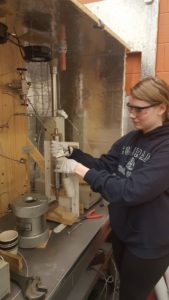Research
CHEMICAL, ELECTROCHEMICAL, AND PHYSICAL PROCESSES FOR TREATMENT OF HIGHLY IMPAIRED WATER FROM OIL AND GAS EXPLORATION AND PRODUCTION ACTIVITIES
Water plays a critical role in the exploration, infrastructure development, and extraction of fossil fuels, especially in unconventional oil and gas (O&G) resources. Water is used in well drilling and well enhancement, and wastewater from these processes and from the O&G extracted require treatment for beneficial reuse. Modern technologies are available to effectively treat highly impaired streams, and make them suitable for irrigation, streamflow augmentation, and even drinking. Cath’s research group is working to optimize the removal of major contaminants (e.g., hydrocarbons, oil and grease, chemical oxygen demand, colloids) from produced water and fracturing flowback wastewater using chemical processes (e.g., chemical coagulation, ozonation, etc.), electrochemical processes (e.g., electrocoagulation), and physical processes (e.g., ultrafiltration and nanofiltration).
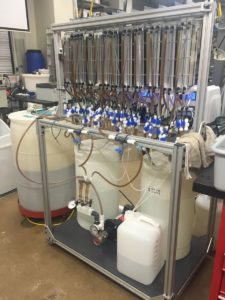
CHARACTERIZING WATER QUALITY OF IMPAIRED WATER FROM OIL & GAS ACTIVITIES
Dr. Higgin’s research is focused on evaluating water quality issues by establishing standard protocols for conducting both traditional water quality analyses (i.e., total petroleum hydrocarbons, gasoline range organics, etc.) as well as unconventional water quality analyses for waters associated with oil and gas hydraulic fracturing. Flowback and produced waters contain complicated and unique matrices causing many traditional methods of extraction and analysis to be inappropriate. Currently my research group is working to characterize the organic component of flowback and produced waters both spatially and temporally using novel liquid chromatography in combination with hybrid quadrupole time-of-flight mass spectrometry (LC-QToF- MS) and gas chromatography–mass spectrometry (GC-MS) methods. Through the use of these advanced technologies, we hope to obtain a more complete “fingerprint” allowing us to identify previously undetected constituents as well as evaluate water treatment systems. The latter is particularly important, as knowing what you are trying to remove is critical when evaluating what water treatment technologies should be employed.
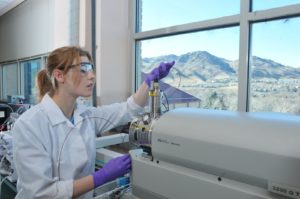
WATER CONSUMPTION FOR UNCONVENTIONAL ENERGY PRODUCTION AND IMPACT ON CURRENT AND FUTURE REGIONAL WATER SUPPLY
Dr. Hogue’s research focuses on the prediction and management of water resources, assessing human impacts on the environment, and understanding the effects of natural hazards, such as droughts and wildfires, on watersheds and long-term water supply. Her WE2ST research focuses on evaluating the consumptive use of water for unconventional energy development and the impact of that consumptive use on local to regional stakeholder needs. Her WE2ST group is also investigating the potential impacts of future climate change on available water supply for energy production and regional stakeholders in the western U.S. Dr. Hogue integrates hydrologic modeling, remote sensing and field observations in her research.
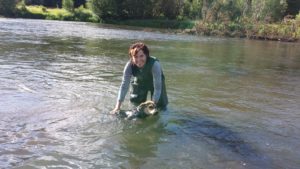
EVALUATING RISKS OF SPILLS AND LEAKS FROM NATURAL GAS PRODUCTION TO LOCAL WATER RESOURCES
Professor McCray and his WE2ST student are engaged in several research activities. One thrust involves using water quality data analysis, experimental investigations, and mathematical modeling to better evaluate the risk of soil, groundwater and stream contamination from accidental surface spills at energy development sites and groundwater contamination due to leaks from faulty well bores. Another thrust area is quantification of water availability and ground-water recharge in water stressed areas with rapidly developing unconventional energy amid competing uses (municipal, agriculture, industry, and recreation).
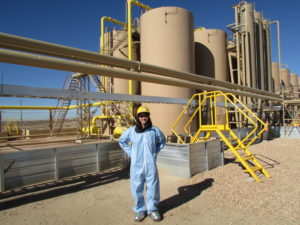
CONSTRUCTED WETLAND CELLS FOR BIOLOGICAL CONTAMINANT ATTENUATION
With a foundation in environmental engineering microbiology, our laboratory group combines molecular / microbial tools with geochemistry and hydrology to understand environmental systems and their relationship to water resources. Our WE2ST project focuses on the role of a constructed wetland environment as a component of treating produced and flowback waters. Photoactive microbial mats have potential for passive, onsite treatment of produced water in a cost effective manner though likely as a component of a larger water treatment train. Just as importantly, the incorporation of constructed wetland environments as a visible element of a water treatment and reuse process, particularly at urban interfaces, may increase public value associated with these extractive efforts through enhanced aesthetics, wildlife habitat, recreational opportunities, and long-term residential or commercial development opportunities.
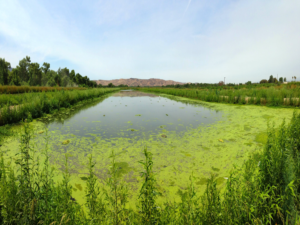
GEOCHEMICAL INTERACTIONS BETWEEN PRODUCED OR RECYCLED WATER AND FORMATION WATER DURING DRILLING OR PRODUCTION OPERATIONS
Water availability for well drilling, completion, and production activities is an area of concern for oil and gas companies and the public. We are researching the potential for use groundwater sources for oil and gas activities in two prominent basins where unconventional production requires large volumes of water for well drilling and completion. Of interest is the prediction of geochemical interactions between the production and formation waters that produce adverse and undesirable effects on well completion or production efficiency. We are specifically interested in the precipitation of salts that can occlude pore space and reduce injectivity or permeability and changes in surface chemistry of minerals that can affect wettability, cation sorption, and formation pH.
To achieve the research objectives we are mapping water quality using publicly available data in the Denver and Permian Basins. We will select water types from production formations and locally available groundwater sources for geochemical and reactive transport modeling of injection of groundwater into producing formations to evaluate the potential for salt precipitation or significant changes in water chemistry that could lead to changes in mineral surface chemistry.
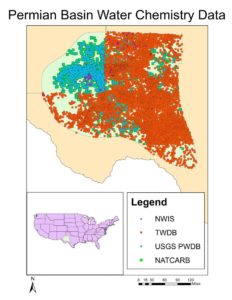
COMMUNITY ACCEPTANCE OF OIL & GAS OPERATIONS
Jessica Smith, WE2ST graduate fellow Skylar Zilliox, and undergraduate student Austin Shaffer (Petroleum Engineering, ’16) are conducting multidisciplinary research to understand the influence of Memorandums of Understanding (MOUs) on relationships among communities, local governments, and oil and gas companies. MOUs are voluntary agreements reached between companies and local governments that establish best practices for managing issues of public concern, such as noise levels, water management, and truck traffic, in exchange for more certain and expedited permitting. As such, they could provide a policy solution for reconciling the interests of the industry, the public, and government entities.
Smith, Zilliox, and Shaffer are combining multiple methods to understand if and how the MOU process in Erie, Colorado, has influenced public opinion and the relationships between the local government and the community, and if and how the MOU process actually addresses community concerns. They are conducting ethnographic research in Erie, focusing on semi-structured interviews with key players from the government, the community, and the companies. This research is complemented with analysis of well data and coding of public hearings
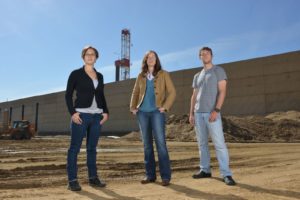
MICROBIOLOGICAL ASSESSMENT IN THE OIL & GAS ENVIRONMENT
John Spear is working with several WE2ST students on the environmental microbiology aspects of their work. Natural waters, produced waters and frac-waters are generally all thought to be dominated and characterized by their chemical properties—the geochemistry of a system. However, in virtually every aqueous environment on Earth except for the extremely high temperature deep sub-surface environment, biology can play a large role in the development of water chemistry. Microbes are highly affected by the geochemistry of a water and vice versa. John and members of his lab group are interested in the microbes associated with sub-surface environments, petroleum environments, produced water environments and in the development of microbial communities in engineered systems designed to treat the waters from these environments.
Typically, we sample an environment and characterize the geochemistry through a suite of tools that then established a meta-data baseline to support the environmental microbiological data. Samples are subjected to light, epifluorescent and scanning electron microscopy (at a minimum), DNA and RNA are extracted from samples and subjected to high-throughput DNA sequencing approaches to first ask (and answer) Who is There? Next, the DNA can be subjected to more in-depth analysis to get at the meta-genome, the total number and kinds of genes present in a sample, or on to complete genome characterization to better understand the inner-workings of the microbes associated with a given water. Correlating all of this data with the geochemical meta-data can reveal exactly what is happening where and why. With that kind of knowledge, both the natural state of a water, or the effectiveness of a treatment state can be determined to better understand or better engineer a system respectively. As an added benefit, throughout the process we are better understanding the microbiota of the Earth—and that better informs on life in general!
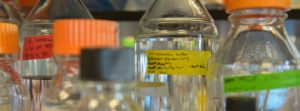
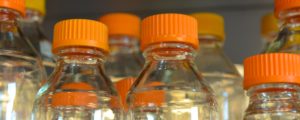
DEVELOPMENT OF AN EFFECTIVE FRACTURING FLUID BY TREATMENT OF OIL AND GAS WASTEWATER
Recycling of the produced and flowback fluid for reuse in the hydraulic fracturing operation yield a three-fold benefit: (a) it alleviates the industry’s dependence on fresh water, (b) it lowers the overall cost of fracturing operation, and (c) it reduces the amount of wastewater injected into deep wells and mitigates the seismic hazard of injection-induced earthquakes. Advances in water treatment technologies make recycling and reuse of produced and flowback water an economic alternative. Both treatment of O&G wastewater and enhancement of O&G extraction are definitely two subjects strongly relevant to the mission of WE2ST.
This research project aims at exploring the fracturing efficiency of produced and flowback water treated to different levels by various water treatment technologies. The main objective of this research is to produce an effective fracturing fluid from O&G wastewater rather than generating fresh water or water for irrigation purposes. Samples of flowback water from fracturing sites along with rock blocks from the outcrops are obtained to explore the feasibility of reusing the water for efficient hydraulic fracturing. Both fracturing flowback and produced water are being treated to different levels and being used for fracturing experiments. This picture shows the WE2ST scholar, Carley Lauer, performing a fracturing test on a rock core. Dr. Reza Hedayat, Marte Gutierrez, and Tzahi Cath are working collaboratively on this research project.
